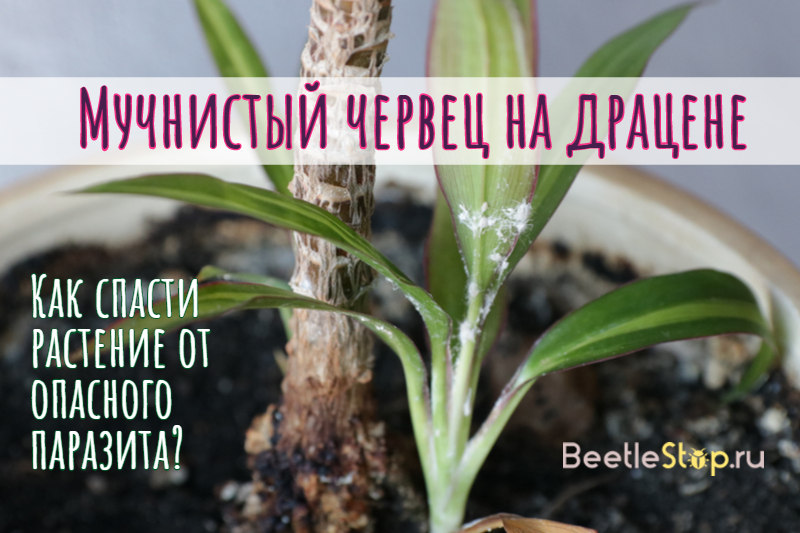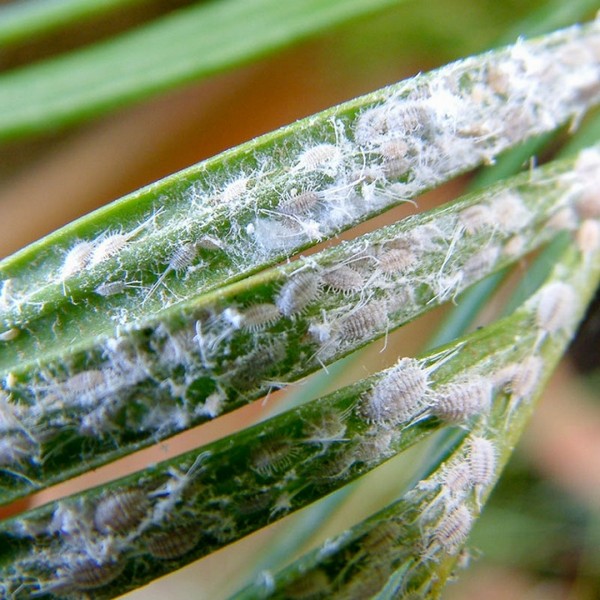How to save a dracaena from a mealybug
Content:

If a mealybug appeared on a dracaena, it is necessary to immediately take measures to save the tropical pet. This parasite is recognized as one of the most dangerous for garden and indoor plants. The worm will not leave voluntarily chosen territory and will drink juice from the flower until it turns it into an arid herbarium.
Signs of infection with dracaena by mealybug
The appearance of white plaque on the stem, leaves of dracaena is a characteristic symptom of infection with a mealybug.
However, there are other signs that will help identify the culprit of the infection:
- At the parasitic sites, a sticky mixture is left, which is called span or honey dew. Of course, there are few who want to taste it, but it tastes sweetish.
- Deformation of the leaves, they begin to turn yellow, lose turgor and, as a result, fall off.
- The curvature of the stem, a decrease in the decorative qualities of dracaena.
- Some leaf fragments may be corroded, as indicated by brown spots.
- White plaque appears not only on the plant, but also on the surface of the flower pot, flowerpot.
- Dracaena looks wilted, lethargic.
- When transplanting, white clusters are found on the root system.
- If you look closely, you can see light shaggy insects.
On a note! The pest is characterized by good mobility, so if you find a mealybug on a dracaena, you should inspect nearby plants.
Pest Summary
In Europe, there are more than 300 species of worms. In total, 2,200 species are known. On dracaena, parasitic is seaside, grape, bristly, cactus and amaryllis. They look almost the same, only a narrow-profile specialist is able to distinguish between them.
Characteristic features of mealybug
The sizes of adults vary in the range from 3 to 7 mm. Occasionally there are larger specimens reaching a length of 9-10mm.
The appearance of the mealybug is very peculiar:
- The individuals are covered with a white coating resembling flour, which predetermined the name of the insect. Wax secretions protect the parasite from moisture loss. Large clusters of insects look like a thin layer of cotton wool or wax.
- Females are wingless, the oval body is strongly flattened on the sides with many legs, covered with a waxy coating. There are threadlike antennae. Color white, grayish, pink, occasionally orange.
- Males are significantly inferior to females in size, but most species can boast of having front wings. There is a bunch of waxy threads on the abdomen. After the third age, males do not eat anything, since the oral apparatus is reduced.
- The larvae essentially represent a small copy of their parents. Sucking mouthpart.
Interesting! Mealybug prefers to populate the leaf sinuses, forms numerous colonies on young shoots of dracaena, and in the case of mass infection, the leaves of the plant.In addition to the leaf form of the pest, there is also a root. Rootworms mainly spend their lives on the roots of plants, but in the case of a lack of nutrients, the aboveground parts are not neglected either.
Features of parasitism
Insects prefer damp, warm, draft protected places. By means of stylet, they are attached to plants and feed on their juices. After mating, females, with the exception of live-bearing species, lay their eggs in a kind of cotton mass. The female fecundity reaches 600 eggs. The period of oviposition lasts 1-2 weeks, after which the females die.
Very often, oviposition is located in the axils of the leaves, cracks in the bark, between the shoots, along the veins, which greatly complicates their detection.

Reliably protected by a downy shell eggs are not afraid of water and many chemicals, which in turn contributes to the preservation of the population. After 10-20 days, young larvae hatch from eggs. Newborn individuals do not yet have any plaque and begin to actively settle in search of a source of nutrition. Choosing a suitable place, they immediately start a meal. The intake of nutrients provokes the release of sticky fluid and the larvae are gradually covered with a characteristic white coating.
For dracaena, parasitization of the mealybug can result in death. Depriving of its juices, the plant begins to lag behind in growth, the leaves turn yellow and fall off. The span secreted by insects becomes a favorable environment for the development of fungal diseases, including sooty fungus.
Causes of the pest
Optimum conditions for the development and reproduction of the insect: high humidity in the room and air temperature within 25 ° C. Spring and autumn are accompanied by a peak in activity of the mealybug, during these periods their numbers are especially high.
Transplanting into the infected soil, taking the plant out to the street increases the chances of a flower becoming infected. But still, mainly, the main factors affecting the development of the mealybug population on Dracaena are care errors:
- excess or deficiency of moisture;
- wrong choice of location of the plant, inappropriate temperature conditions, increased humidity in the room;
- lack of regular water procedures, inattentive inspection of the flower for insects, untimely removal of dead fragments, diseased leaves;
- ignoring quarantine measures after acquiring a new plant.
On a note! Lack of attention to soil disinfection is the reason for the appearance of many pests on indoor plants. Before transplanting dracaena to a new soil, the soil is kept in a freezer or treated with boiling water, 1% manganese solution. When using an old flower pot, the container also needs to be disinfected.
Mealyworm Methods
If single individuals are found, they are removed with tweezers, and the leaves and windowsill on which the plants are located are treated with a soap-and-water solution. To prepare it, a teaspoon of ground soap or green soap is dissolved in hot water. Then bring to a volume of 1 liter and add a tablespoon of medical alcohol. After covering the substrate in a flowerpot, spray Dracaena with a spray gun. A regular visual inspection is carried out for a month to make sure that offspring are not present.
If the number of mealybugs exceeds 10, dracaena needs treatment. All visible individuals are removed with a toothpick, cotton swab, tweezers, and the plant itself is treated with a chemical preparation. For the treatment of leaves and stems, the following products are used:
- "Actellik" - destroys pests in one procedure. The drug is toxic, so do not neglect personal protective equipment.
- "Aktara" - used for soil application and leaf spraying.For complete disposal of insects, 2 treatments are required.
- "Intavir" is a preparation of intestinal contact action.
Also used are “Tsvetofos”, “Fosbetsis”, “Decis”, “Fitoverm”, “Confidor”. For tillage use Talstar, Bazudin, Arrivo.
Important! Before using the drug, a test should be conducted on the susceptibility of the plant to the agent. For this, one sheet is treated and the reaction of dracaena is monitored for 1-2 days. Many insecticides are toxic to humans, so the treatment is carried out in a well-ventilated area, it is possible on the street, in rubber gloves.
Treatment of dracaena from mealybug involves 2-3 treatments. The drugs do not have an ovicidal effect - they do not have a detrimental effect on the eggs of pests. Therefore, after 7-10 days, in order to destroy the new offspring, the procedure is repeated.
Folk recipes
Most gardeners are skeptical about the use of folk remedies, considering them ineffective against pests. However, in the early stages of infection, they can help in the fight against harmful insects.
How to get rid of mealybug on dracaena:
- 1-2 teaspoons of any antiparasitic shampoo for cats or dogs based on permethrin mixed with 5 liters of water and spray the leaves, stem.
- To prepare the garlic solution, grind 5 cloves of garlic, pour a liter of boiling water and leave for 3-4 hours. Strain the finished mixture and apply with a brush or fleece to all areas of the plant.
- Pour 50 g of citrus peels with a liter of warm water. After the solution is infused for 24 hours, pour it into a spray bottle and spray the dracaena.
- Calendula tincture wipe infected areas. It is important that the plant at this moment is not in the sun. In the absence of a ready tincture, pour 100 g of dried flowers with a liter of water and incubated for at least 24 hours.
- In the case of the appearance of a root mealybug, a plant transplant helps well. Soil and pot are pre-disinfected. The plant itself is carefully removed from the soil and the roots are placed in a container of water at 55 ° C for 15-20 minutes.
Important! In the treatment of dracaena from mealybugs, it is isolated in a separate place. All nearby plants are regularly inspected with a magnifying glass and, if necessary, they are treated.


 (votes: 18, average rating: 4,89 out of 5)
(votes: 18, average rating: 4,89 out of 5)